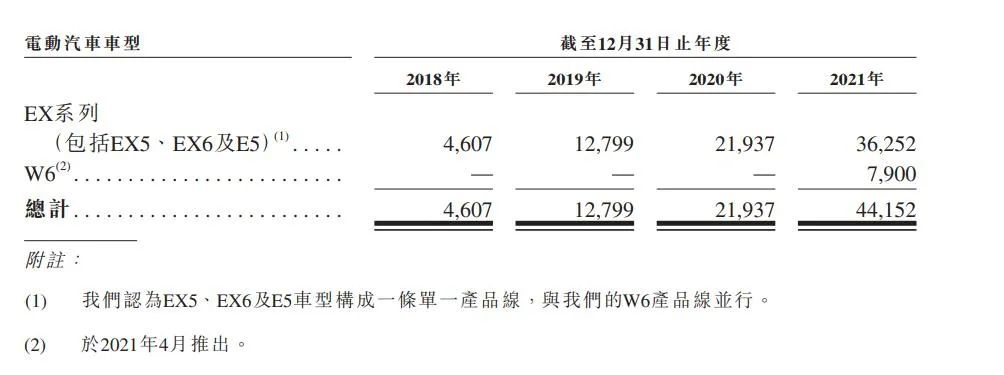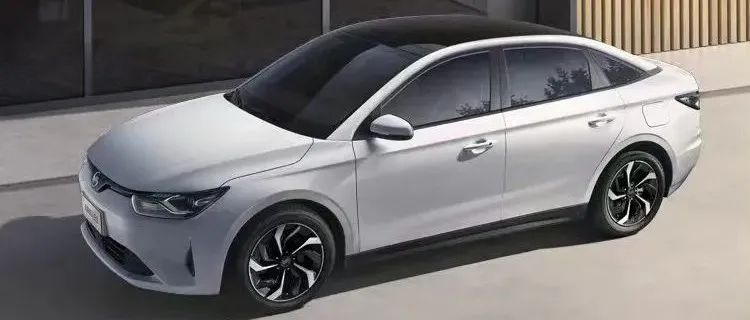Translation in English Markdown
Author | Leng Zelin
Editor | Wang Pan
Recently, WM Motor officially submitted its prospectus in Hong Kong, aiming for an IPO.
As one of the “Four Little Dragons” in the past, WM Motor has gradually been surpassed by “WmAuto Wuling” in recent years, and its sales have fallen into the second tier. Last year, it failed to debut on the Science and Technology Innovation Board due to insufficient technological content, casting a shadow over its future.
Unlike other new car manufacturers, WM Motor has no direct sales stores, and relies entirely on distributors to expand its offline channels (as of December 31, 2021, WM Motor has a total of 621 partner stores and plans to gradually open direct sales stores from 2023). It is also not proactive in revealing its sales figures at the beginning of each month, making it little known to outsiders.
Apparently, wanting to make up for its past “regrets,” WM Motor is very fond of using words like “first,” “most,” and “only” in its prospectus. According to search tools, the word “most” appeared 478 times in the prospectus, “first” appeared 41 times, “only” appeared 15 times, and “first-ever” appeared 20 times.
Number one in terms of sales:
In 2021, our sales of electric SUVs ranked first among all pure electric vehicle manufacturers in China’s mainstream market, and our electric vehicle and smart electric vehicle sales ranked third among all local car manufacturers in China’s mainstream market.
The largest and fastest-growing segmented market:
The mainstream market refers to the segmented market of electric vehicles with suggested retail prices of RMB 150,000 to RMB 300,000, which is the largest and fastest-growing segmented market in China’s electric vehicle industry.
The largest number of pure electric vehicle models:
After launching our M7 in the second half of 2022, we expect to have a total of 5 models, making us the company with the largest number of electric vehicle models launched among all pure electric vehicle manufacturers in China from 2018 to 2022.
The only mass-produced model of L4 level automatic driving function:
In our product line, our W6 is the world’s first and only mass-produced electric vehicle model with L4 level automatic driving function achieved by its AVP (Automatic Valet Parking) or (Memory) AVP function to park in designated parking spaces at home or workplace.
The best-selling electric SUV:
As of December 31, 2021, our EX5, an affordable smart electric vehicle, is still the best-selling electric SUV in China’s mainstream market based on cumulative sales.
In addition, there are also the largest number of usage scenarios, industry-first, and the only OTA technology, the first and only automaker with a dual operating system, and so on.
With so many firsts, it is reasonable to expect that research and development investment would increase as well.
According to the information in the prospectus, Weltmeister (WM) has ranked first among its domestic counterparts in R&D spending last year, reaching 20.7%. H, a subsidiary of WM, specializing in extended-range electric vehicles, had an R&D spending ratio of 12.2% last year. Photon Motor checked and confirmed that this company should be Li Auto.
The total revenue of Li Auto last year was about RMB 27.02 billion, with R&D expenses of RMB 3.29 billion, while WM has only spent a total of RMB 2.87 billion on R&D over the past three years.

Not only has the R&D spending ratio been continuously decreasing, but the value has also dropped in 2021.
If we compare them carefully, at present, Li Auto has only one model on sale, with L9 not yet being launched, while WM has already launched four models, with M9 to be launched in the second half of this year. In comparison, such R&D spending is not much.

So is it the continuously increasing sales that have led to substantial revenue growth and the resulting decrease in R&D spending ratio?

According to the data provided in the prospectus, WM ranked first in both lists mentioned above. The prospectus also mentioned that there are currently about 70 Chinese electric vehicle manufacturers.
However, if we observe carefully, not all of these 70 companies participate in the competition of these lists, but need to meet certain “conditions.”
Firstly, it is the mainstream market (15-30 million RMB), which means companies such as NIO and Xpeng will be excluded; secondly, pure electric vehicle manufacturers, such as Li Auto, which used to be compared, as well as traditional automakers such as BYD will also be excluded; finally, SUVs, and so-called automakers such as Xpeng that primarily produce sedans are also unlikely to make it to the list.
How many companies are left in the end? At least companies established in 2019 and 2021 can make it to the list, making it somewhat lacking in confidence.

When it comes to revealing the real sales data, WM has also spent some “effort.”
EX5, EX6, and E5 were merged and counted into the EX series, because it was believed that these three models constituted a single product line parallel to the W6 product line.By checking the data of sales volume, it can be found that WmAuto EX6 has sold 37, 14, 11, 7, and 3 units respectively in the past five months.
There is a reason given by WmAuto in the prospectus risk warning for the poor sales of EX6: “The outbreak of the national epidemic in early 2020 and the government’s implementation of blockade and restrictive measures have a significant adverse effect on the marketing and sales of our newly launched EX6.”
Meanwhile, the monthly sales volume of W6 is also not high, with less than 1,000 units on average, and the first mass-produced model EX5 targeting the travel market is the main force of the overall sales volume.
A large part of the sales of EX5 depends on a plan called “customer cooperation partner,” which rewards users with points for recommending friends to become WmAuto fans and users. In 2021, this plan contributed about 40% of the sales volume of the EX5 model.
As a result, WmAuto’s three-year losses reached RMB 4.15 billion, RMB 5.08 billion, and RMB 8.21 billion, totaling about RMB 17.44 billion. The problem of vehicle gross margin has not improved either, being -58.8%, -50.4%, and -54.6% respectively over the past three years.
Where did the main expenses go? From changes in research and development, sales and marketing, and administrative expenses, it is somewhat puzzling that the first two remained basically flat during these three years, while administrative expenses have significantly risen from RMB 840 million in 2019 to RMB 2.7 billion in 2021.
From the administrative expense table shown above, it can be seen that employee compensation has increased the most.
From the perspective of the number of employees, WmAuto had 2,639, 2,899, and 3,952 employees during the three-year period. Compared with 2019, the number increased by about 49.8%, which obviously does not match the over 220% increase in administrative expenses.
The answer was found in the section of the Board of Directors and senior management. WmAuto’s board of directors currently comprises 11 members, including four executive directors, three non-executive directors, and four independent non-executive directors. The members are Shen Hui, Du Ligang, Hou Haijing, Bi Yijia, Li Zhenyu, Peng Shuolong, Jiang Shaoqing, Wu AITO, Gao Feng, Li Jin, and Wang Huai.According to the prospectus, the total amount of pay and benefits (including remuneration, salaries, bonuses, employee restricted stock or stock option expenses, pension plan contributions, housing and other allowances) paid to directors in the three fiscal years ending on December 31, 2021 was CNY 7.7 million, CNY 20.5 million, and CNY 17.456 billion, respectively.
The total amount of pay and benefits (including salaries, bonuses, equity-based payments, pension plan contributions, housing and other allowances) paid to Weima’s five highest-paid employees in the three fiscal years ending on December 31, 2021 was CNY 9 million, CNY 25.07 billion, and 17.455 billion, respectively.
Weima also emphasized that the group has not paid or is obligated to pay any remuneration to directors or the five highest-paid employees as incentives to join the company, or as severance payments related to management of any subsidiary, nor have any directors waived any remuneration.
According to data from QCC, Weima has disclosed financing amount exceeding 30 billion yuan.
The proceeds from this IPO will be used to develop automobile development platforms and next generation intelligent electric vehicles, expand sales and service networks, manufacture relevant products, repay loans, and for general corporate purposes and working capital.
The prospectus also reveals Weima’s future plans.
Weima is currently developing the Caesar chassis platform, which is expected to be launched in 2023. The platform will adopt leading SiC MOSFET electric drive technology, shortening fast charging time from 30%-80% to 10 minutes.
The upcoming Weima M7 will still be based on the Ajax chassis platform, but will be equipped with Weima’s self-developed L4 level AVP, and its hardware configuration will support L5-level autonomous driving functions.
In addition, Weima is expected to release an upgraded version of the W6 with ANP (autopilot navigation system) in Q3 2022. This likely refers to a new generation of the W6, as the old version is unlikely to have the ability to obtain ANP function through OTA.
Regarding ANP, the prospectus mentions that it is an L2+ driving assistance system that uses Weima’s proprietary technology and integrates with a leading Chinese technology company. This refers to Baidu, but the proprietary technology used is unknown.
SUVs, sedans, and MPVs based on the Caesar chassis platform will be launched in 2023, and Weima expects to release a new vehicle model every year in the near future.To maintain long-term competitiveness, WM Motor still has many issues to address.
The prospectus also revealed that as of the final feasible date, there were several lawsuits between WM Motor and Geely Group, including a “commercial secret dispute” in which Geely Group accused WM Motor of infringing its commercial secrets and claimed compensation of about CNY 2.1 billion and related litigation costs. In another “intellectual property dispute” case, Geely Group claims ownership of 27 registered patents held by WM Motor and two patent applications, and claimed compensation of CNY 1.16 million.
Both disputes have been concluded and are expected to be judged by the end of 2022.
As of the final feasible date in the cases against Geely, WM Motor may have completed the relevant technical solutions or patents involved in commercial secret and intellectual property disputes, or have formulated replacement or elimination plans, and is expected to complete the process from late 2022 to mid-2023.
Is WM Motor in danger? Time will tell, but it should focus on participating in market competition instead of playing word games.
This article is a translation by ChatGPT of a Chinese report from 42HOW. If you have any questions about it, please email bd@42how.com.
